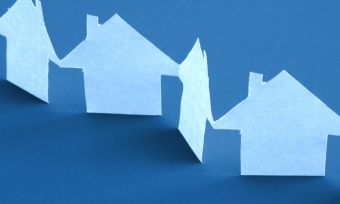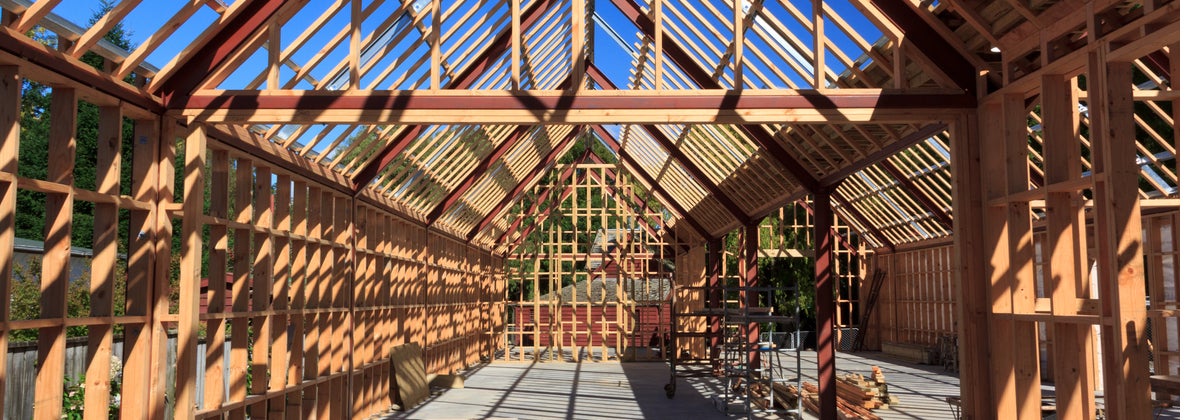How Much to Build a New House in NZ? In this article we cover:
- Median cost of buying an existing house in NZ
- Rising costs of building a new house
- We’re building more, smaller homes
- Hidden costs of building a new home
- Build or buy, which is cheaper?
In August 2020, we first published our article: How Much to Build a New House in NZ? Since then, we’ve updated it regularly, and it remains one of the most popular articles on Canstar’s website.
So, over the past few years, how have things changed? Well, one thing remains the same: Auckland is still the most expensive place in NZ to buy property. But the recent surge in building costs has pushed up the cost of building a new home across the country. And once you factor in the price of a section, buying an existing home can often be a cheaper option.
Median cost of buying an existing house in NZ
Over the past two years, as inflation rose to a peak of 7.2%, and mortgage rates soared, the value of the country’s housing stock dropped. Over the year to October 2022, according to statistics from REINZ, the median national house price dropped 12.2%.
Since then, to September 2023, it’s dipped a further 3.1%, to $785,000. In Auckland that figure’s a little less pronounced, down 2% to just over $1m.
This fall in the value of our housing stock is reflected in median house prices around the country. In all but three regions, median house prices have fallen over the past year. And let’s just ignore Marlborough’s result for the month. God knows what happened there during September, there must have been a few very expensive house sales… cos if you look at the previous two months’ figures, August’s year-on-year numbers were down 9% and July’s were flat at +0.3%.
| Region | Median Price Sept 2023 |
YoY Change |
| Auckland | $1,015,000 | -2% |
| Tasman | $810,000 | -5.8% |
| Bay of Plenty | $800,000 | -5.3% |
| Wellington | $782,000 | -4.6% |
| Waikato | $745,000 | -3.9% |
| Marlborough | $740,000 | 25.4% |
| Hawke’s Bay | $700,000 | -1.4% |
| Northland | $700,000 | -3.4% |
| Canterbury | $680,000 | 0.7% |
| Nelson | $680,000 | -2.7% |
| Otago | $661,000 | -0.6% |
| Taranaki | $581,500 | -7.7% |
| Gisborne | $550,000 | -3.7% |
| Manawatu-Whanganui | $530,000 | -7% |
| Southland | $450,000 | 0% |
| West Coast | $390,000 | 8.3% |
Cheapest home loan rates
If you’re currently considering a home loan, the table below displays some of the 2-year fixed-rate home loans on our database (some may have links to lenders’ websites) that are available for first home buyers. This table is sorted by Star Rating (highest to lowest), followed by company name (alphabetical). Products shown are principal and interest home loans available for a loan amount of $500K in Auckland. Before committing to a particular home loan product, check upfront with your lender and read the applicable loan documentation to confirm whether the terms of the loan meet your needs and repayment capacity. Use Canstar’s home loan selector to view a wider range of home loan products. Canstar may earn a fee for referrals.
Rising costs of building a new house
But while existing homes’ values are dropping, the costs of building new homes are still rising. Over 2022, the nation experienced double-digit building cost inflation of 10.4%. And, so far this year, prices have continued to increase.
Looking at the building consent applications from January to August this year, construction costs are up 12%, nationally. Although, regionally, there is quite a difference in the inflation numbers, only one region, Nelson, has shown any reduction in costs:
| Region | $ per m² in 2022 | Jan-Aug 2023 | % Increase |
| Northland | $2855 | $3490 | 22% |
| Wellington | $3072 | $3412 | 11% |
| Otago | $3252 | $3409 | 5% |
| Bay of Plenty | $2898 | $3353 | 16% |
| Auckland | $2908 | $3219 | 11% |
| North Island | $2884 | $3208 | 11% |
| Hawke’s Bay | $3029 | $3199 | 6% |
| New Zealand | $2820 | $3145 | 12% |
| Tasman | $2795 | $3137 | 12% |
| Waikato | $2767 | $3127 | 13% |
| Nelson | $3106 | $3019 | -3% |
| South Island | $2661 | $2982 | 12% |
| Gisborne | $2655 | $2880 | 8% |
| Marlborough | $2637 | $2857 | 8% |
| Canterbury | $2469 | $2855 | 16% |
| Manawatu-Whanganui | $2650 | $2814 | 6% |
| West Coast | $2538 | $2772 | 9% |
| Taranaki | $2583 | $2745 | 6% |
| Southland | $2574 | $2694 | 5% |
Note, it’s important to remember that prices vary build to build, depending on the size and design of a home, and the above figures are just estimates based on national building consent applications, which don’t include the full costs of building a new home. For more on the hidden costs of building a new home, see below.
As building costs per m² have increased so, too, have the average prices of consented new builds in most regions:
| Region | Average new build price 2022 | Jan-Aug 2023 | % Increase |
| Northland | $487,994 | $542,755 | 11% |
| Otago | $530,973 | $540,355 | 2% |
| Tasman | $480,654 | $527,769 | 10% |
| Marlborough | $469,530 | $500,557 | 7% |
| Southland | $470,940 | $484,682 | 3% |
| Waikato | $441,266 | $457,579 | 4% |
| Wellington | $369,702 | $449,366 | 22% |
| South Island | $408,668 | $446,054 |
9% |
| New Zealand | $408,415 | $442,132 |
8% |
| North Island | $408,319 | $440,738 |
8% |
| Bay of Plenty | $453,559 | $438,872 | -3% |
| Hawke’s Bay | $490,519 | $438,395 | -10% |
| Auckland | $393,016 | $432,869 | -2% |
| Taranaki | $433,312 | $421,657 | -3% |
| Nelson | $447,615 | $417,012 | -7% |
| Manawatu-Whanganui | $440,414 | $416,593 | -5% |
| Canterbury | $365,815 | $412,615 | 13% |
| Gisborne | $317,646 | $356,340 | 12% |
| West Coast | $349,924 | $348,212 | -0.5% |
If you’re wondering why average prices haven’t risen by the national average of 12% and, instead, have only gone up approx 8%, and have even dropped in some regions, that’s because we’re building smaller houses. On average, the homes built this year are 10% smaller than those consented back in 2020.
We’re building more, smaller homes!
While myriad factors affect the cost of a new build, one thing is clear, we’re building more, smaller homes. Ten years ago, we were building fewer homes than in the mid-1970s. However, since then the pace of building has ramped up.
In 2022, the number of new dwellings consented was 49,538, up 26% from 2020’s number. But as you can see below, the homes we’re building are getting smaller.
| Years | 1974 | 2000 | 2010 | 2020 | 2021 | 2022 | Jan-Aug 2023 |
|---|---|---|---|---|---|---|---|
| Homes consented | 39,525 | 25,010 | 28,038 | 39,420 | 49,007 | 49,538 | 25,836 |
| Average floor area | 110m2 | 166m2 | 182m2 | 156m2 | 154m2 | 145m2 | 141m2 |
Region to region, while there’s still quite a difference in the size of the houses we’re building, pretty much across the board all the homes are getting smaller. This is especially true in our big urban centres, where thousands of new town houses and apartments are being built.
For example, in Auckland there were 10,938 new dwellings consented in the first eight months of this year. But only 2758 (25%) were houses. The other 8180 (75%) were apartments, townhouses and units.
| Region | Average Size 2020 | Average Size 2021 | Average Size 2022 | Average Size 2023 |
| Southland | 186m2 | 178m2 | 183m2 | 180m2 |
| Marlborough | 192m2 | 193m2 | 178m2 | 175m2 |
| Tasman | 179m2 | 177m2 | 172m2 | 168m2 |
| Otago | 168m2 | 168m2 | 163m2 | 159m2 |
| Northland | 180m2 | 177m2 | 171m2 | 156m2 |
| Taranaki | 168m2 | 164m2 | 168m2 | 154m2 |
| South Island | 167m2 | 161m2 | 154m2 | 150m2 |
| Manawatu-Whanganui | 164m2 | 172m2 | 166m2 | 148m2 |
| Waikato | 170m2 | 171m2 | 159m2 | 146m2 |
| Canterbury | 163m2 | 156m2 | 148m2 | 145m2 |
| New Zealand | 156m2 | 154m2 | 145m2 | 141m2 |
| Nelson | 167m2 | 162m2 | 144m2 | 138m2 |
| Hawke’s Bay | 158m2 | 148m2 | 162m2 | 137m2 |
| North Island | 152m2 | 153 m2 | 142m2 | 137m2 |
| Auckland | 148m2 | 146m2 | 135m2 | 134m2 |
| Wellington | 133m2 | 132m2 | 120m2 | 132m2 |
| Bay of Plenty | 154m2 | 157m2 | 156m2 | 131m2 |
| West Coast | 159m2 | 151m2 | 138m2 | 126m2 |
| Gisborne | 175m2 | 132m2 | 120m2 | 124m2 |
Searching for the Cheapest Personal Loan?
If you’re looking for the cheapest personal loan, Canstar’s personal loan comparison tables can help. The table below displays the sponsored unsecured personal loan products available on Canstar’s database for a three-year loan of $10,000 in Auckland, with links to lenders’ websites. Use Canstar’s personal loan comparison selector to view a wider range of products on Canstar’s database. Canstar may earn a fee for referrals.
Hidden costs of building a new home
“Construction prices are stabilising, says Trent Simpkin, of Arcline Architecture. “I actually asked a bunch of builders the other day how they were finding it, and they said timber and steel prices have come down slightly, but they’re still seeing price increases in other materials.
“Supply is good; there are no delays on materials, which makes project management a lot easier. However, it’s not at all unusual to see build prices in the $4000s per m², for a normal New Zealand family home.
“We recently had a simple, rectangular, mono-pitch roofed home on a relatively level site priced at $5700m², which two to three years ago would have been around $3000m².
“Another project we ran our estimating tools on was $1,038,000 18 months ago. Builders have now priced it at $1.15m to $1.2m. So there’s a 10% to 15% real increase on the final build cost of a house. So I’d say that the average cost of a normal house is now creeping towards $4000m² and to budget on that figure as an absolute minimum.
“This year, we feel that material supplies have caught up with demand. Plus, there are fewer projects on the go, and more builders available. However, I don’t think this will mean any significant drop in construction costs at this point.”
However, even without building cost inflation, when pricing a new build, there are other factors involved that can push up costs.
“When most architects and designers submit building consent applications the build value figure we put in is as low as possible, to keep the consent costs down. Because the value of the build impacts the consent fee,” says Trent.
“Yes, it could be considered inaccurate, but councils should only need to know the value of the consentable items. So, for example, if we say a house is $2500m² on a consent application, in reality, it’s more of a $3500m² build.
“The shape and circumference of a home are big players in the cost of the build, too. A square house has the least perimeter of any shape, so is the cheapest to build, as it requires less cladding, insulation, roofing, etc. Whereas a house the same size split into individual pods will cost more.”
If you’re trying to keep costs down, Trent advises to avoid the following, which could push the cost of your build well over $4000m².
- Elevated sites, exposed to the wind
- Steep (or even not so steep) sites that require retaining walls
- Unsuitable ground requiring engineering design
- Large square metres of glass (requiring steel portals)
- Open expanses of living areas (requiring engineering due to lack of walls to brace)
- Cantilevered decks, roofs, floors
- Expensive cladding, like cedar, and roofing, such as tray roofing
- Difficult site access
- Any build methods that are time consuming
→ Related article: Building Costs Per Square Metre in NZ: Busting the Myth
Build or to buy? Which is cheaper?
Before we start the sums, let’s just make it clear that we’re talking about averages here. Construction costs, the price of existing properties, and land prices vary from region to region, suburb to suburb and house to house.
But it’s clear that the rise in construction costs has pushed up the price of new builds to a level where they are comparable, and often more expensive, than buying existing homes once you factor in the cost of land.
The most recent government report into land prices reveals that in Auckland, back in 2021, urban-zoned land was valued at around $1300 per m², in Tauranga it was $1100 per m², while in Wellington, Hamilton and Queenstown prices ranged ranged between $400-$500 per m².
The median point in these numbers is around $850 per m². So let’s say the average price is $800m², because when applied to a typical 500m² section, it works out to a cost of $400,000, which is in line with a new report by the BNZ, which uses a base cost of $400,000 for the average NZ section.
So if you add the average cost of building a home in NZ ($442,132) to the cost of an average section ($400,000), you get: $842,132.
And what was the national median house price according to REINZ, yep: $785,000 – so, yes, buying a section and building a new home on it could well end up costing you considerably more than just buying the average house.
Although, at least if you buy a new property, you shouldn’t have to worry about renovation or upkeep costs for a few years!
Lowest construction loans
If you’re considering a new build, big or small, wherever you are in the country, it’s worth reading our story What is a Construction Home Loan. For as you’ll see, the structure of a loan to build a new home is usually different to a standard home loan, and usually feature floating rates during the construction stage.
If you’re currently considering a home loan, the table below displays some of the floating home loans on our database (some may have links to lenders’ websites) that are available for home owners looking to refinance. This table is sorted by Star Rating (highest to lowest), followed by company name (alphabetical). Products shown are principal and interest home loans available for a loan amount of $500K in Auckland. Before committing to a particular home loan product, check upfront with your lender and read the applicable loan documentation to confirm whether the terms of the loan meet your needs and repayment capacity. Use Canstar’s home loan selector to view a wider range of home loan products. Canstar may earn a fee for referrals.
About the author of this page
This report was written by Canstar’s Editor, Bruce Pitchers. Bruce has three decades’ experience as a journalist and has worked for major media companies in the UK and Australasia, including ACP, Bauer Media Group, Fairfax, Pacific Magazines, News Corp and TVNZ. Prior to Canstar, he worked as a freelancer, including for The Australian Financial Review, the NZ Financial Markets Authority, and for real estate companies on both sides of the Tasman.
Enjoy reading this article?
You can like us on Facebook and get social, or sign up to receive more news like this straight to your inbox.
By subscribing you agree to the Canstar Privacy Policy
Enjoy reading this article?
You can like us on Facebook and get social, or sign up to receive more news like this straight to your inbox.
By subscribing you agree to the Canstar Privacy Policy







Share this article